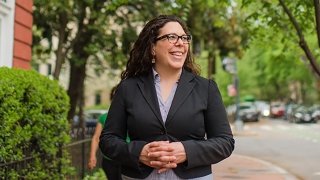Dara Zeehandelaar Shaw PhD ’12 has spent much of her career addressing education policy issues as the national research director for the Thomas B. Fordham Institute, an education policy think tank located in Washington, DC. In February, she became executive director for research, assessment and accountability for the state of Maryland Department of Education. We asked her to reflect on her new role.
How has your focus shifted moving from a national organization to a state agency?
At national education policy think tanks, researchers like me are looking at issues that affect education in every single state. Most education policy decisions happen at the state level. For example, rules determining policies for gifted and talented education are made by each individual state. The same with state standards and accountability. There’s no federal policy on these issues.
At Fordham, I conducted research and made policy recommendations for state leaders, so in that sense, my work was nationwide in scope. Whereas at my new job, I design and implement an agenda that produces useful, actionable research for just one state — Maryland.
What are the big education issues that Maryland is facing?
I would say that the number one issue that Maryland is dealing with — and I would imagine every other state as well — is implementation of the Every Student Succeeds Act (ESSA). We are devoting tremendous resources to shaping the state’s ESSA accountability plan to make sure, first, that there is an appropriate standard of rigor for the students and, second, that our schools are meeting that bar.
And within this larger focus, we’re looking at how we are ensuring equity across student populations, supporting educators and schools that aren’t meeting their goals, and how we are going to pay for everything in our plan.
California has a population of 40 million, whereas Maryland has just 6 million residents. Are your challenges also smaller in scale?
Maryland might be a lot smaller than California, but it’s not necessarily simpler here. Yes, there are advantages to only having 24 districts, but that does not mean it is any easier. In California, your sheer numbers might pose obvious challenges but that large size can also be an advantage. For example, it might be a lot easier to get funding for an intervention for a small percentage of your students because that number still represents a significant size overall.
But in Maryland, one percent of students is a very small number. And regardless of size, we still have to make sure we are addressing the diverse needs of every student and student group in our state, regardless of numbers.
Are there lessons California can learn from Maryland?
It’s not so much what California can learn from Maryland specifically, but what states can all learn from each other right now. For example, both California and Maryland — and a host of other states — are figuring out how to hold schools accountable under ESSA. We all have the same questions to which there are no absolute “right” answers. Should the components of the accountability system be “rolled up” into a single, summative score, or left as components? What concepts should those components capture, and how will they be defined, measured and calculated?
California’s accountability system is going to look different from Maryland’s, but we’re both going through the process of figuring out the answers to these questions. We’re looking at what evidence research can provide us. We’re listening to what stakeholders like educators, parents, students, lawmakers and taxpayers have to say. And we’re determining how to proceed based on the needs of our unique student populations. While California shouldn’t copy Maryland’s system, or anyone else’s, states can learn a lot by studying how others are developing their systems, regardless of what system they choose in the end.




